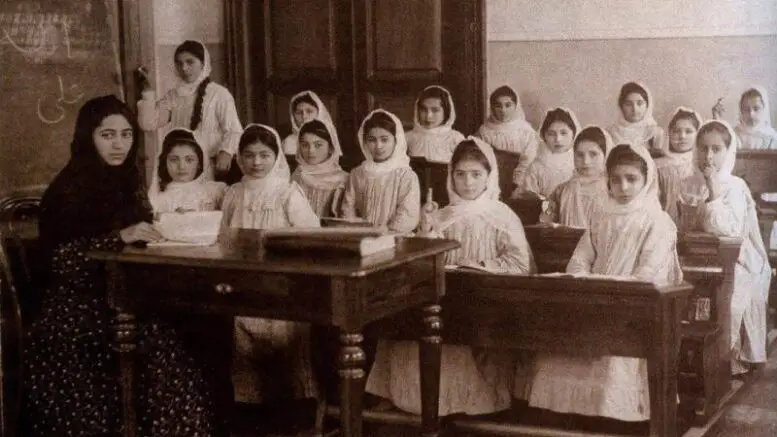Audrey, Altstadt. The Politics of Culture in Soviet Azerbaijan, 1920-1940. Routledge, London and New York, 2016. 234pp, $65pb. ISBN 9781138639003.
“We are undertaking the maximum development of national culture, so that it will exhaust itself completely and thereby create the base for the organization of international socialist culture.” -Joseph Stalin.
In The Politics of Culture in Soviet Azerbaijan: 1920-40 (2016), author Audrey L. Altstadt’s main thesis is that, for Azerbaijanis and other non-Russians, the “forms” of their culture (folk dance, poetry, painting) survived under Soviet rule and “were used by the Soviet regime to support its claims to cultural construction and nation-building,” however, the “substance” of native culture, “the content of the vessels in national form, as embodied in language, written in literature, and taught in schools … became a battleground with enormous casualties.”[1] Altstadt describes how the Soviet regime, in implementing its nationalities policy, destroyed the burgeoning local national consciousness and identity.[2]
On the way to class consciousness, Lenin and Stalin argued that a national consciousness must first be established. Thus, the Soviet nationalities policy existed to create a Soviet class consciousness. These policies were applied differently to different nationalities based on their level of “cultural backwardness.”
Altstadt asks and answers the question: “What if these identities designated under ‘cultural backwardness’ were not culturally underdeveloped?” In approaching this question she describes her historiographical approach as following a “parallax” method. Based off the term parallax used in astronomy to distinguish the importance of perspective, Altstadt denotes this “parallax” method as utilizing historical, intellectual, literary, linguistic, and institutional perspectives to construct a multi-faceted analysis. Alstadt states the method is needed because “viewing situations and processes from different perspectives is essential to the study of the human experience.”[3] Altstadt argues that the Soviet government’s classification of Azerbaijan as backwards was erroneous and that the immense wealth of oil-rich Azerbaijan helped lead to a pre-World War I national consciousness in Azerbaijan.[4]
Altstadt, a professor of History at the University of Massachusetts-Amherst, is one of the most renowned scholars writing in English on Azerbaijan’s history under the Soviet Union. Altstadt’s first book, The Azerbaijani Turks: Power and Identity under Russian Rule (1992), is highly praised for its accounts of Azerbaijani nationalism and identity at the beginning of the 20th century. The Politics of Culture in Soviet Azerbaijan: 1920-40 is an offshoot of her first book and the product of, as Alstadt put it, “nearly 20 years of research, writing and rewriting.”[5] In her grassroots-level analysis, one can see the strong influence of Sheila Fitzpatrick’s distinctive Social Revisionist approach, in particular shown in Fitzpatrick’s monograph Education and Social Mobility in the Soviet Union 1921-34, which reviews roughly the same time period that Altstadt analyzes.
Similar to Fitzpatrick, Altstadt uses a large amount of context to preface historiographical arguments, providing valuable in-depth introductions to an anglophone reader. These deep contextual dives can at times be engrossing, yet Altstadt’s writing is not consistently engaging throughout the book. For example, Alstadt’s deep dive into the pragmatic and politically driven development of the Oriental Faculty at Azerbaijan’s sole university holds a fascinating conclusion, however the many pages leading up to it are leaden in prose.[6]
Altstadt also differs from Fitzpatrick, oversimplifying the 1930s with catch-all descriptions of terror and a monolithic view of Stalinism. In this case Altstadt’s arguments align more with the Totalitarian school of historiography, compared to the Revisionist Social History the rest of her arguments subscribe to. Nonetheless, she does an excellent job of bringing to life Azerbaijani culture before the Bolsheviks, and how it both withstood and was reconstituted under Soviet control.
In the first chapter, “The Azerbaijani Enlightenment,” Alstadt posits that Azerbaijan was developing the seeds of a modern secular society in the late nineteenth century when it was an administrative region of the Russian Empire. Azerbaijani scholars had a common vision that “learning would elevate their Muslim Turkic community to the level of contemporary Europe which they identified with Enlightenment, reason, science & technology, social reform, political participation and constitutionalism.”[7] With the oil rush of the 1870s, Baku became a multicultural industrial hub. Alstadt argues that the secular elite of Azerbaijan were well positioned to define a unique Azerbaijani identity based on language, ethnicity, and territory. The intelligentsia promoted their Turkic culture, moving away from ties to Arabic and Persian states; however, the Russian language became more widespread at this time with Russia consolidating its political control in the region as it developed its commercial interests there.
Altstadt argues that “Secularism and European Romanticism led Azerbaijanis to replicate the pattern of codifying language, recording folk tales, writing history and defining common values that formed a national consciousness.”[8] The burgeoning elites hoped to develop an “ethnic secular identity,” and to use socialism as a means to break from tsarism. After the revolution, Azerbaijan established a secular government while under British occupation from November 1918 until the summer of 1919. Alstadt is a clear advocate of what the republic, though short lived, was able to achieve, as “the first Muslim society to establish a republic, conduct multi-party elections, and enfranchise women”[9] as well as opening a university which served both men and women.
However, change came rapidly and dramatically when the Red Army entered Azerbaijan the night of April 27, 1920. Alstadt postulates that “contrary to the oft-repeated claims of passivity, Azerbaijanis fought against the occupation” [10]. Altstadt’s argument that Azerbaijan resisted the Soviets could have been stronger if she had mentioned Azerbaijan’s pragmatic, though unsuccessful, effort to thwart a Soviet takeover by annexing itself to Iran.[11] As Hamid Ahmadi writes in his essay “The Clash of Nationalisms Iranian: Response to Baku’s Irredentism”:
To avoid the threat of Soviet invasion and the more important threat of an Armenian invasion, the Muslim enclave of Nakhichevan proposed annexing to Iran. … [At the Paris Peace Conference in 1919, the Iranian delegation] went through intensive negotiations with Musavat party leaders amid the increasing instability and chaos in Baku. At the final stage, an agreement was reached between them, but before presenting the idea to Vosough in Tehran, the communists took over Baku and ended the Musavat–Ottoman rule.[12]
In describing the era that followed, Alstadt hones in her principal theme – how the Soviet nationalities policy unfolded in Azerbaijan over the next two decades.
Alstadt shows how Soviet efforts to mold Azerbaijani culture into a piece of the USSR were intended to create a disconnect from Türkiye and from Azerbaijani Turks in Iran. The Soviets forced changes to the Azerbaijanis to switch from a modified Arabic script to a modified Cyrillic script. Eventually this meant that Azerbaijanis could no longer read historical texts written in Arabic, which the culture had used for centuries. Alstadt ironically writes: “The Russian language came to be associated with cultural progress and Cyrillicized Azerbaijani became the vehicle for the edification and uplifting of the younger brother.”[13]
The most detailed and deeply researched part of Alstadt’s work is her fourth chapter, “Schools: educating citizens or ‘human material’?”. The analysis of educational systems in Soviet Azerbaijan is strikingly similar to Sheila Fitzpatrick’s approach to evaluating Stalinism from a social history perspective. Alstadt discusses the debates among Azerbaijani bureaucrats and party leaders involved in the educational system. She also discuss the politically motivated purges and the experience of the mostly ethnic Russian urban proletariat and the mostly rural Turkic Azerbaijani peasant class. Alstadt digs into the details of government data and planning documents for schools and aptly calls out an increasingly narrow focus from a “broad and humanist vision … to Stalin’s goal of creating cogs for the party regime.”[14]
Alstadt goes on to describe the contrast between the Bolshevik propaganda trumpeting educational successes and the reality of the executions of many Azerbaijani educational and literary leaders in purges in the late 1930s. These victims were branded as “two-faced counterrevolutionaries” and “fascist dogs”[15] and there was a widespread purging of “counter-revolutionary teachers” from Azerbaijani schools. To illustrate the changes shaping Azerbaijani society, Alstadt presents the reader several highly detailed case studies.
Altstadt’s The Politics of Culture in Soviet Azerbaijan: 1920-40 shines a light on an area of history less studied in the Anglophone world: Stalinist era Azerbaijan. She effectively dispels the myth that Azerbaijan suffered “cultural backwardness” and builds a strong case that Azerbaijan could have effectively modernized had the Bolsheviks not invaded. This work is a critical contribution to understanding Soviet rule in non-Russian republics, drawing on a plethora of sources ranging from Azerbaijani archives to the multiple works of well-respected historian Sheila Fitzpatrick.
I would enthusiastically recommend this book to anyone wishing to learn about Azerbaijani cultural history, the Soviet nationalities policy, the Imperialist and Orientalist implementations of modernization, and Soviet Orientalism.
Footnotes
[1] Ibid., 54.
[2]An example of this rewriting of identity is through the university curriculum designed by Marxist historian M.N. Pokrovskii, in which Russian colonialism was initially taught as an “absolute evil”. However, over time, this shifted to a “lesser evil” and finally to an “absolute good” saving the “backwards people” by granting them an opportunity to be part of the “greatest event in the history of mankind”, the Great Socialist October Revolution. Ibid., 53.
[3] Altstadt, The Politics of Culture in Soviet Azerbaijan, 1920-1940 (London: Routledge, 2016), xiii.
[4] Ibid., xiii.
[5] Ibid.
[6] Ibid., 150.
[7] Ibid., 1.
[8] Ibid., 7.
[9] Ibid, 26 [10] Ibid, 27 [11] Ahmadi, Hamid. “The Clash of Nationalisms Iranian: Response to Baku’s Irredentism.” Essay. In The Great Game in West Asia Iran, Turkey and the South Caucasus, 108. New York, New York: Oxford University Press, 2016. [12] Ibid[13] Ibid., 88.
[14] Ibid., 119.
[15] Ibid., 125.



